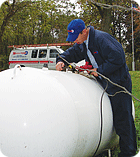
Last year's rise of hurricane activity brought attention to the necessity of having backup power to maintain lighting and appliances. Backup generators powered by liquefied petroleum (LP) gas have become a necessity for people living in hurricane states. A survey by the Propane Education & Research Council (PERC) last July found that 48 percent of adults in hurricane-prone states (9 million households) expected to lose their electricity for at least 24 hours at some point during the last six months of 2006.
While the need for LP gas in emergency situations continues to fuel its demand, what about everyday use of LP gas? Are Americans turning to LP as an alternative fuel source, or possibly as a primary source, to run their HVAC equipment?
The use of LP gas in rural settings is more common, given the expense and availability of natural gas or oil.
"Propane is everywhere natural gas is not," said Tim Johnson of Propane Plus, Rehoboth, Mass., whose customer base is 95 percent propane users and 5 percent natural gas. "In our area (15 miles east of Providence, R.I.), 75 percent of all homes are fuel oil beyond the gas mains. It is a deal where our area is dependent on oil companies with no storage capacity keeping the energy level cheaper on average than propane.
"Providence is so close to us, so all you need is an oil truck to be in business. That is why it is so prevalent. Everywhere else in the country propane is booming. People want it and don't want the hassle of fuel oil."
But where homeowners have a choice, are more turning to propane instead of natural gas, oil, or electricity? According to the American Housing Survey (AHS) data:
M. Scott Gregg, a master plumber with over 20 years of industry experience, recently authored a white paper to help home builders understand why gas, both propane and natural, should serve as the primary energy source for hot water and hydronic heating systems. The paper examines total lifecycle costs of high-efficiency propane heating systems to help homebuilders understand how quickly upfront costs are recovered through reduced annual energy bills.
"There is virtually no reason why homes off the main shouldn't be using propane to provide hot water and fuel hydronics systems," Gregg said. "If one of the barriers is related to aesthetic issues due to a propane tank, the solution is simple: Work with your propane marketer to install the tank underground."
One contributing factor to the increased use of propane is the recent surge in popularity of outdoor rooms. Knowledge Networks conducted a survey of 1,010 home-owners in 2005; 35 percent had a finished outdoor room; one in three who did not have one were planning to build one within the next year. The survey concluded that more than half the homes in the United States could have an outdoor entertaining area in 2007. Propane appliances dominate the list of accessories (outdoor heaters and fireplaces) for these rooms.
David Mason, owner of Climatech LLC, Marlette, Mich., said that 55 percent of his customers use propane to heat their homes in an area where LP gas is the dominant fuel supply. "Propane is cleaner than oil," he said. "It offers more options in the home (appliances, etc.)." In Michigan, a major propane market area, propane's share grew from 6.1 percent to 9.4 percent over the past decade, according to PERC.
Speaking of clean, LP gas has been recognized by the World LP Gas Association as a major source for lowering greenhouse gases (GHG), which the association cites as the principal cause of climate change. The association said a switch to LP gas could lower GHG emissions compared to conventional energy fuels in these areas:

CONTRACTORS SPEAK OUT
Some HVAC contractors note that energy prices will not favor switching to LP gas, since it is a byproduct of natural gas processing and petroleum refining. "I would not anticipate that since it is a petroleum-based product and will probably mirror any price changes of natural gas," said Randy Chollar, owner of C&J Air Conditioning & Heating Co., San Antonio, Texas. Fewer than 1 percent of Chollar's customers use LP gas. He said his market for propane is neither increasing nor decreasing.The 2005 energy averages (compiled by the DOE's Energy Information Agency from Northeast states' data) showed that an average house uses 822 gallons of fuel oil for heat and hot water annually. The average cost of LP gas for one year was $2,523, placing it third behind oil ($1,247) and natural gas ($1,463).
In states like Vermont, where retired contractor Ken Secor lives, homeowners have a choice between gas, oil, or wood. "Gas [NG or LP] would be my first choice for many reasons," he said. "Oil is noisy, more expensive, requires fuel storage on site, requires more maintenance, and is generally more expensive to buy and install. LP is a tad cheaper than No. 2 oil. I would say LP and No. 2 each have roughly one-third market share each. The remaining third is wood."
Roger Mitchell of the Maine Oil Dealers Association attributes the popularity of decorative hearth products as a reason for the growth of the propane market. "Some companies just do propane installations, but it is mostly the room heater and decorative stove stuff," he said. "The growth area of propane is the hearth and home market with heaters like Rinnia, Empire, Vermont Castings, and Vanguard."
According to the Hearth, Patio & Barbeque Association (HPBA), shipments of hearth products increased to 3.2 million in 2005 compared to 2.9 million in 2004. Gas and propane products accounted for 66 percent of the total shipments.
Still, Mitchell thinks oil is the preferred choice for primary heating. "Oil is cheaper."

"Propane, oil, or electric is what is available outside the city limits," he said. "Natural gas is predominant within city limits with less than 1 percent oil within city limits."
Mason said that in his area, some communities restrict the installation of propane tanks. But in areas where propane tanks are allowed, home builders are turning to the use of underground propane tanks, according to a survey by the National Association of Home Builders (NAHB).
The survey of 294 builders showed that 34 percent of the homes built in 2005-06, in locations with partial or no access to NG, feature an underground propane tank.
"Underground tanks are clearly the way to go," said Bruce Bylsma, director of sales and marketing for Sable Developing, a home builder from Rockford, Mich.
"Buyers like the aesthetics with the absence of a tank, and they see propane as more cost effective than electricity and better for developing both off the grid and off the natural gas main. Propane gives homeowners all the benefits they need to live comfortably in a home."
Rob Brown of Northeast Radiant Technology LLC, Gardiner, Maine, said, "Oil is cheaper per Btu than propane, but you can rock the efficiency with propane which, in most of the calculations I do, tends to balance it out," he said; "that is unless you can keep an oil boiler in very good condition (i.e., at least twice yearly cleanings and maintenance) and if you use reset controls and such to maximize its running efficiency.
"But versus your typical oil boiler install, which is almost never anywhere near its AFUE rating and is not being maintained diligently, I would say go propane. It's not a clear-cut issue though, for sure, and it can vary heavily depending on your region and costs."
SERVICE TRAINING AND EQUIPMENT
Since LP gas and natural gas have the same basic properties, there is little to be done to modify a furnace. "It only requires the addition of an inexpensive propane conversion kit on the furnace," said Chollar.But there are enough differences to require extra training for service techs. Training available through the National Propane Gas Association (NPGA) is called Certified Employee Training Program (CETP). MODA's Mitchell said, "The state of Maine adopted the training as qualification for licensure back in the late 90s. We provide the training so our members can get the training and support at the same time.
"The technicians use the training to become licensed so they can perform more duties and increase their earning potential. We have had some students just do the propane course, get the license, and go to work immediately after class. The majority of our members now sell propane and need the technicians for on-call duties and normal work volumes, so a lot of companies pay for the training and send the students to class."
One contractor said any training is welcome. "A little more would be good for the propane trade," said Mason. "That includes how to identify where and how propane is more corrosive than natural gas, and a lesson on propane density. "Everything works the same just at a lower pressure and smaller orifices due to propane's higher Btu content than natural gas. Regulators are different but the same idea applies."
Johnson said he has been sold on using propane for a long time. "Propane has no disadvantages - it actually is a great energy," he said.
For more information on propane gas, visit www.propanecouncil.org or www.worldlpgas.com.
Publication date: 11/06/2006

Report Abusive Comment